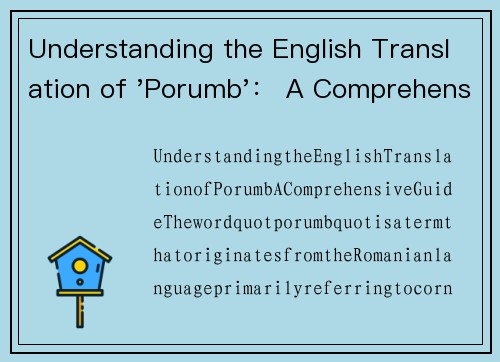The word "porumb" is a term that originates from the Romanian language, primarily referring to corn or maize. In this comprehensive guide, we will delve into the various aspects of this term, its cultural significance, agricultural importance, and its translation into English. Understanding "porumb" goes beyond mere translation; it encompasses the agricultural practices, culinary uses, and cultural implications associated with this staple crop.
Corn, or "porumb," is one of the most widely cultivated crops in the world. It is a staple food in many countries, particularly in the Americas and parts of Africa and Asia. In Romania, porumb holds a significant place in agriculture, serving as a primary source of food for both humans and livestock. The cultivation of porumb is deeply rooted in Romanian tradition, with many farmers relying on it for their livelihoods.
The growth cycle of porumb typically spans several months, requiring specific climatic conditions to thrive. It is a warm-season crop that prefers well-drained soil and ample sunlight. Farmers often engage in crop rotation to maintain soil health and maximize yield. Understanding the agricultural practices surrounding porumb is essential for appreciating its role in Romanian culture and economy.
In Romania, porumb is not just a crop; it is an integral part of the culinary landscape. It is used in various forms, from fresh corn on the cob to ground cornmeal used in traditional dishes. One of the most popular Romanian dishes made from porumb is "mămăligă," a cornmeal porridge that is often served as a side dish or base for stews and meats. Mămăligă is similar to Italian polenta and is cherished for its versatility and comforting texture.
Additionally, porumb is used to make a variety of snacks and street foods, such as roasted corn and corn fritters. The sweet flavor of fresh corn is celebrated during summer festivals, where vendors sell grilled corn on the cob, often enjoyed with a sprinkle of salt or cheese. Understanding the culinary applications of porumb provides insight into its cultural significance and the ways it is woven into the fabric of Romanian life.
Porumb is more than just a food source; it symbolizes sustenance, tradition, and community in Romanian culture. Harvest festivals often celebrate the corn harvest, where communities come together to honor the agricultural bounty. These festivals feature traditional music, dance, and food, showcasing the importance of porumb in bringing people together.
Moreover, porumb is often associated with rural life and the values of hard work and perseverance. Many Romanian folk tales and songs reference corn, highlighting its role in the lives of farmers and their families. Understanding the cultural narratives surrounding porumb enriches our appreciation of this simple yet profound crop.
The economic significance of porumb extends beyond local consumption. Romania is one of the largest producers of corn in Europe, exporting a substantial portion of its harvest to other countries. The corn industry supports numerous jobs, from farming to processing and distribution. Understanding the economic impact of porumb is crucial for grasping its role in the global agricultural market.
In recent years, the demand for corn has increased due to its use in biofuels and animal feed. This shift has led to changes in farming practices and crop management strategies. Farmers are now adopting more sustainable practices to meet the growing demand while ensuring environmental stewardship. The economic dynamics surrounding porumb reflect broader trends in agriculture and globalization.
四虎影视伊甸园When translating "porumb" into English, the most straightforward equivalent is "corn." However, it is essential to note that the term "corn" can have different meanings depending on the region. In American English, "corn" specifically refers to maize, while in British English, it can refer to any grain. Therefore, understanding the context in which "porumb" is used is vital for accurate translation.
In addition to its direct translation, "porumb" can also be used metaphorically in various contexts. For instance, it may symbolize abundance or prosperity in literary works. Recognizing these nuances is essential for anyone looking to translate or interpret texts that include the term "porumb."
Translating terms like "porumb" presents unique challenges, particularly when considering cultural connotations. Words often carry meanings that extend beyond their literal definitions, influenced by historical, social, and cultural contexts. For example, while "porumb" may simply translate to "corn," its significance in Romanian culture cannot be fully captured in a single word.
Translators must navigate these complexities, often providing additional context or explanations to convey the full meaning. This process requires a deep understanding of both the source and target cultures, as well as the ability to communicate nuances effectively. The translation of cultural terms is an art that goes beyond language, requiring sensitivity to the values and traditions embedded in the words.
In conclusion, understanding the English translation of "porumb" involves much more than simply translating a word. It encompasses the agricultural practices, culinary uses, cultural significance, and economic impact of this vital crop. As we explore the various dimensions of porumb, we gain a deeper appreciation for its role in Romanian society and its broader implications in the global context.

What does "porumb" mean in English?
What are some traditional Romanian dishes made with porumb?
Why is porumb culturally significant in Romania?
How does porumb impact the Romanian economy?
What are the challenges in translating "porumb"?
Is porumb used in any non-food products?
How is porumb cultivated?
销售热线
营销一部(传统产品):王部长 15371160678
营销二部(光伏焊带):曹部长 13921871003
电子邮箱
shuddering@msn.com
公司地址
福建省宁德市蕉城区闽东中路763号